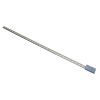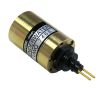Zebra-Tech LI-COR LI-192 Hydro-Wiper
Features
- Highly effective brush technology for both marine and fresh water
- Precision on-board clock for accurate wipe interval timing
- Simple sensor installation and operation with user-replaceable brush
- Free ground shipping
- Expedited repair and warranty service
- Lifetime technical support
- More
Overview
The Zebra-Tech LI-COR LI-192 Hydro-Wiper is a mechanical wiper system designed to fit easily to the LI-COR LI-192. Using a regular gentle brushing action, the Hydro-Wiper keeps the optical window of the LI-COR LI-192 clean from bio-fouling and other unwanted deposits such as mud. The Hydro-Wiper reduces the need for costly site visits to manually clean the instrument, maintaining data integrity throughout long deployments.
Self-Contained
The Zebra-Tech LI-COR LI-192 Hydro-Wiper consists of a wiper unit attached via a purpose-designed clamp. The wiper is connected to a rugged underwater housing, which contains the batteries, control electronics, diagnostic LED and wipe interval select switch.
Data Logger Controlled
The wiper is connected to the Hydro-Wiper control module by an electrical cable. To initiate a wipe, the data logger simply sends a trigger signal to the control module. Synchronizing the wipe with measurements ensures data quality is consistent throughout the deployment.
- (1) Zebra-Tech LI-COR LI-192 Hydro-Wiper self-contained system
- (1) Field kit
- (1) Operations manual
In The News
Wildfire Prevention in the Sierra Nevada Region with the Yuba Watershed Institute
Though recent wildfires have sparked new conversations about wildfire management and response, groups like the Yuba Watershed Institute have been monitoring the forests and water resources of the Sierra Nevada region for decades, managing approximately 5,000 acres of land with the Bureau of Land Management (BLM) and about 7,000 acres in private land partnerships. The goal of the Institute is to work with local communities and land agencies to improve watershed and forestry management through informed practices and public outreach. The goals of the Yuba Watershed Institute are three-fold: Improve the ability of fire suppression agencies like the California Department of Forestry and Fire Protection ( CAL FIRE ) and the US Forest Service.
Read MoreWave Sensors Integration with NexSens Buoys: A Cutting-Edge Solution for Wave Measurment
Real-time wave data supports accurate weather prediction, safe and efficient maritime operations, and provides valuable safety and operating condition information for recreation and commercial fishing. Understanding wave dynamics also helps with the design of protective coastal structures like seawalls, breakwaters, and jetties. It also supports better prediction of their impact on sediment transport and coastal geomorphology. Wave data is a key factor in qualifying and designing offshore wind farms and harnessing kinetic energy for electrical generation. It helps with the understanding of ocean-atmosphere interactions and contributes to studies of sea-level rise and climate change impacts.
Read MoreSpring 2025 Environmental Monitor Available Now
In the Spring 2025 edition of the Environmental Monitor, we highlight partnerships across the world and the importance of collaboration between government agencies, universities, environmental groups, local communities, and other stakeholders. From great white shark research in Cape Cod to monitoring fisheries in Lake Erie, this latest edition underscores partnerships that connect stakeholders in a watershed through environmental data. With an emphasis on data sharing, a combination of real-time and discrete sampling keeps the public and partners informed of environmental conditions. Our writers also sought out science professionals dedicated to working with peers within and outside of the environmental sector.
Read More











